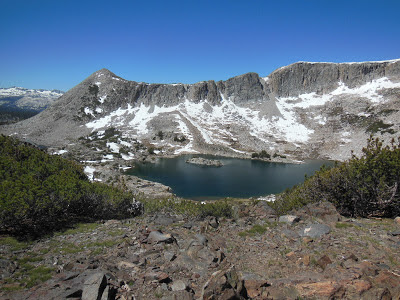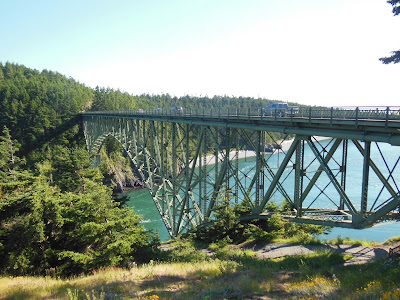We arrive home yesterday after almost 9 weeks on the road. We saw lots of new places and some places we've been before. We spent time with family and friends and thoroughly enjoyed the entire trip. We drove over 8,000 miles and never had problem one with the truck or trailer. We will now get ready for our next adventure to Europe in the fall, but first here's the final chapter in this adventure.
We spent our last week in the Eastern Sierras for some hiking in some of our favorite areas. Bridgeport, Lee Vining and Bishop. We managed 5 hikes in 7 days but I'm not going to go into great detail. I'll post some photos with captions of the locations, but at the end of this post we'll explore some really important and interesting findings from our high altitude hikes. Now for some photos:
We spent our last week in the Eastern Sierras for some hiking in some of our favorite areas. Bridgeport, Lee Vining and Bishop. We managed 5 hikes in 7 days but I'm not going to go into great detail. I'll post some photos with captions of the locations, but at the end of this post we'll explore some really important and interesting findings from our high altitude hikes. Now for some photos:
BUCKEYE CREEK IN BUCKEYE CANYON NEAR BRIDGEPORT
E.T. PHONE HOME
IRISES NEAR BRIDGEPORT
EAGLE CREEK HIKE NEAR BRIDGEPORT
PRETTY
WE SAW LOTS OF INITIALS CARVED IN THE ASPENS
ALONG EAGLE CREEK. THIS ONE FROM 1925!
MORE FLOWERS ALONG EAGLE CREEK
A WINDY DAY AT LOWER TWIN LAKE, BRIDGEPORT
WE HIKE ALONG THE TUOLUMNE RIVER IN YOSEMITE
THE CASCADES
MORE OF THE CASCADES
PACK TRAIN OVER THE TUOLUMNE RIVER
CATHIE COMING UP THE TRAIL INTO
GAYLOR LAKES BASIN, YOSEMITE
GAYLOR LAKE
GAYLOR LAKES BASIN
LOOKING DOWN FROM 11,000 FEET AT GRANITE LAKE
YOURS TRULY ABOVE GRANITE LAKES
MINER'S CABIN GAYLOR LAKES IN BACKGROUND
UPPER AND LOWER GAYLOR LAKES WITH
GAYLOR PEAK IN BACKGROUND
A couple of years ago I climbed Gaylor Peak. At just over 11,000 feet it is just a short cross county hike from the trail leading into the basin.
We moved down to Bishop and after a day of rest, we hiked up to Tyee Lakes. The trail head is a 9100 feet and the upper lake is at 11,100 feet, so you do the math. 2000 foot gain in a little over 3 miles.
WATER FALL ON THE WAY UP
LOOKING BACK AT THE FIRST LAKE
LAKE NUMBER TWO
UPPER LAKE
RESTING
SOME OF THE MANY FLOWERS WE SAW ON THIS HIKE
We saw so many flower on the entire trip so in the future I might just do a post with just the flowers. Now for that exciting information I promised.
I have been a many high altitude hikes, with Mt. Dana at over 13,000 feet my highest climb. Cathie too has been up there at over 11,000 feet. We've noticed something that occurs on a regular basis while hiking at these altitudes. We have numerous bouts of flatulence. Yes, we fart, pass gas, cut the cheese or break wind. Call it what you like, but it happens frequently to us at high altitude. So I was thinking; could it be that the decrease in atmospheric pressure causes the gas inside to expand and be released uncontrollably?
Cathie noticed this phenomenon with me as she usually lets me lead the way, but I also noticed on our frequent breaks that she too suffers from anal audio. So if this is true could it also be true that when you descend from the heights, and the pressure increases causing the gas accumulated at high altitude to be squeezed out?
I think so, but to prove my theory and perhaps to write my doctoral thesis on the subject I think I will petition the government for a grant to study this important subject. Imagine the trouble the astronauts must have in zero gravity. My findings just might save a life. I figure Washington is always giving away money to the 47% so why can't I get in on the action? I know my United States Senator, Nancy "we have to pass it so you will know what's in it" Pelosi would support such an important study. Don't you think?
I have been a many high altitude hikes, with Mt. Dana at over 13,000 feet my highest climb. Cathie too has been up there at over 11,000 feet. We've noticed something that occurs on a regular basis while hiking at these altitudes. We have numerous bouts of flatulence. Yes, we fart, pass gas, cut the cheese or break wind. Call it what you like, but it happens frequently to us at high altitude. So I was thinking; could it be that the decrease in atmospheric pressure causes the gas inside to expand and be released uncontrollably?
Cathie noticed this phenomenon with me as she usually lets me lead the way, but I also noticed on our frequent breaks that she too suffers from anal audio. So if this is true could it also be true that when you descend from the heights, and the pressure increases causing the gas accumulated at high altitude to be squeezed out?
I think so, but to prove my theory and perhaps to write my doctoral thesis on the subject I think I will petition the government for a grant to study this important subject. Imagine the trouble the astronauts must have in zero gravity. My findings just might save a life. I figure Washington is always giving away money to the 47% so why can't I get in on the action? I know my United States Senator, Nancy "we have to pass it so you will know what's in it" Pelosi would support such an important study. Don't you think?



























































